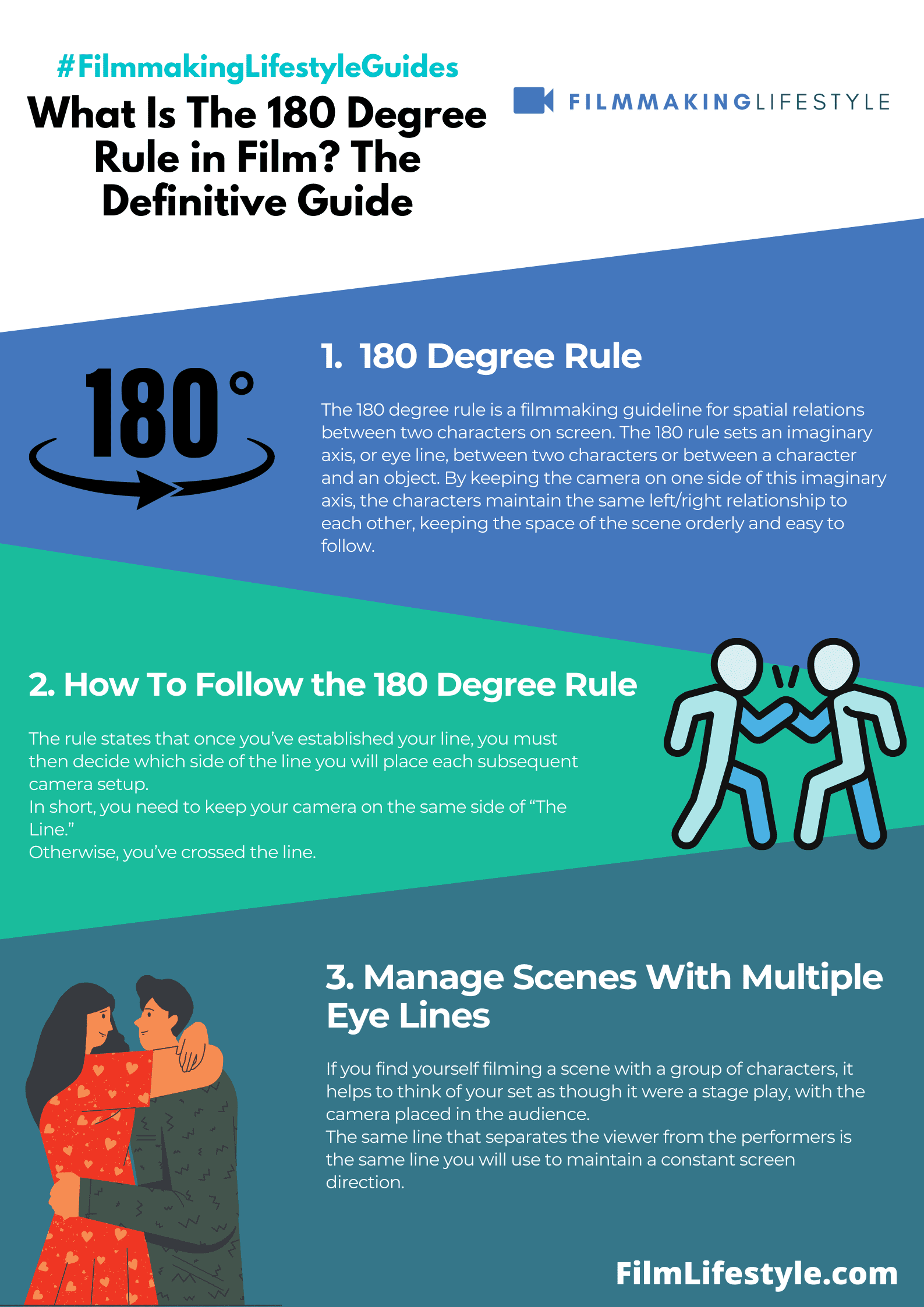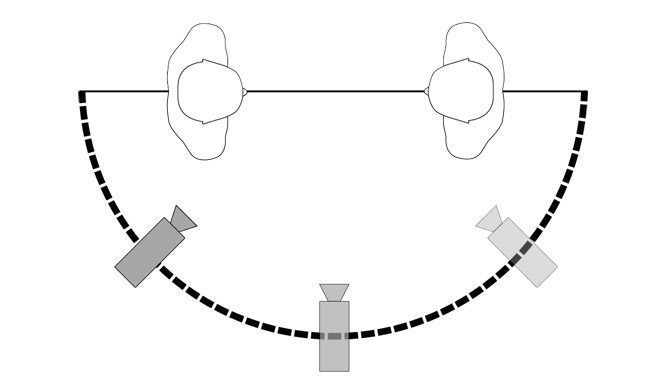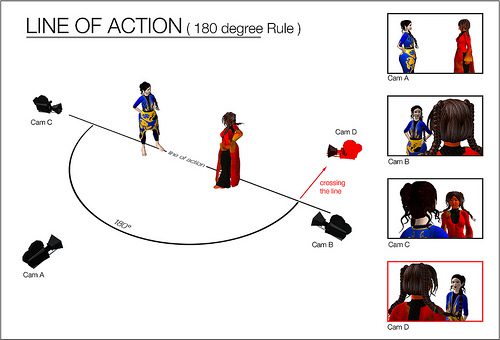The 180 Degree Rule is a photography rule that can be applied to all types of photography such as landscapes, portraits, and still lifes.
The most common application is in landscape photography where the photographer has to decide which direction they want their subject to face.
180 degree rule
What Is The 180 Degree Rule in Film?
The 180 Degree Rule is a basic rule of filmmaking. It states that you can only have one actor on the screen at a time, and they should be facing in opposite directions from each other.
To keep it simple, when two actors are talking to each other on the screen, they must not be looking at each other directly.
The camera can either move between them or cut back and forth between their reactions as long as it does not show both actors at once.
In the world of film, the 180 Degree Rule isn’t just a suggestion—it’s the backbone of visual storytelling.
It’s a fundamental guideline that keeps viewers anchored in the on-screen action, ensuring spatial consistency and continuity.
We’ll dive deep into how this rule shapes the way we perceive character interactions and maintains the illusion of a coherent space.
Stick with us as we unravel the mysteries of this essential cinematic principle and explore why breaking it can either be a blunder or a stroke of genius.
What Is The 180 Degree Rule In Film?
Understanding the 180 Degree Rule is pivotal for anyone looking to master film language.
It’s a cinematography guideline that dictates how cameras can move around subjects.
The rule imagines an invisible line, or axis, that runs through the scene.
It connects the main subjects and acts as a boundary, preventing camera placement from crossing onto the other side.
This principle ensures that the relative position of characters remains consistent.
When applied effectively, it provides viewers with a stable and coherent spatial orientation.
Filmmakers follow this rule to maintain directional continuity.
Here are some key reasons why it’s essential:
- It avoids disorienting the audience,
- It ensures a clear understanding of the scene’s geography,
- It preserves the visual and narrative flow.
Breaking the 180 Degree Rule can be artistic and intentional.
But it must serve a purpose and add value to the storytelling process.
In films like The Shining, deliberate deviations from the rule have profound effects.
They can create feelings of unease and confusion that enhance the film’s psychological impact.
Seasoned directors know how to manipulate the rule to their advantage.
They understand when maintaining the viewer’s orientation is crucial and when it’s appropriate to challenge the audience’s perception.
By respecting this fundamental tenet of film language, we strive to create visually engaging and narratively coherent works.
Our goal is to harness these rules to serve the story we’re telling.
The Importance Of The 180 Degree Rule
When diving into the mechanics of film production, the 180 Degree Rule emerges as a cornerstone of visual storytelling.
This unwritten law plays a pivotal role in orienting the audience within the cinematic space.
By adheriting to the rule, filmmakers create a seamless and comprehensible narrative flow.
We ensure the audience knows where characters are in relation to one another, sustaining their immersion in the story world.
But, when considering the spatial dynamics between characters, this rule becomes even more critical.
It curtails confusion during conversations or action sequences by maintaining consistent screen direction.
Let’s look at the tangible gains from this practice:
- Simplified editing process – footage from multiple camera angles can be cut together cohesively,
- Enhanced audience engagement – keeping viewers grounded in the storyline without spatial disorientation,
- Professional output quality – adherence to such protocols is often what separates amateur footage from professional-grade film.
On the other hand, the deliberate choice to break this rule marks a radical departure from convention.
Filmmakers like Stanley Kubrick utilized this technique in The Shining to craft a disorienting experience, aligning with the film’s psychological themes.
Understanding and employing the 180 Degree Rule is integral to our toolkit as filmmakers.
It bolsters our narrative’s clarity and ensures that every piece of the filmic puzzle slots perfectly into place.
How The 180 Degree Rule Works
Imagine a straight line running through a scene – this is the axis of action.
Filmmakers place cameras on only one side of this axis to capture the shots.
By doing so, we ensure that characters maintain the same left/right relationship to each other, fostering spatial awareness for the audience.
To grasp the mechanics further, let’s consider a simple dialogue scene.

If character A is on the left and character B on the right, subsequent shots must honor this arrangement.
Should cameras cross the axis, the characters would appear to switch places, creating confusion.
What guides us in applying this principle effectively?
Here are some methods:
- Maintaining a consistent background for characters to solidify their positions in the scene,
- Using an establishing shot to set up the spatial relationships before cutting to closer angles,
- Organizing shots in sequences that follow the continuity of the 180 Degree Rule to avoid visual jarring.
Another facet of this rule involves movement.
When a character walks or any action traverses the scene, we keep the direction consistent from shot to shot.
If someone moves from left to right in the first shot, they continue in that direction in subsequent shots.
We also account for camera movement.
Panning or tracking should follow the direction of action, respecting the established axis.
This technique maintains the illusion of a three-dimensional space on a two-dimensional screen.
Practical challenges arise when filming intricate scenes with multiple characters or complex movements.
In these cases, we anchor our work with motivated camera moves.
These are shifts in the camera’s position that have a clear reason related to the story or action, keeping the 180-degree rule intact while adding dynamic visuals.
Utilizing the 180 Degree Rule isn’t just about sticking to a guideline; it’s about harnessing a tool that aids in the storytelling process.
It ensures the audience remains oriented and connected to the unfolding narrative, allowing us to craft films that resonate both visually and emotionally.
Examples Of The 180 Degree Rule In Film
One of the most revered examples of the 180 Degree Rule can be found in Alfred Hitchcock’s North by Northwest.
During the famous crop-duster scene, Hitchcock masterfully maintains spatial consistency Even though the chaos, ensuring the audience stays oriented.
Another iconic use of the rule is evident in Steven Spielberg’s Jaws.
Spielberg employs the rule to enhance the tension during the shark attack sequences.
The clear sense of space amplifies the terror and suspense without disorienting the viewer.
We frequently observe the 180 Degree Rule in long dialogue scenes to maintain a clear conversational flow.
A prime example is Quentin Tarantino’s Pulp Fiction.

With fast-paced dialogue, Tarantino keeps the camera over the shoulders of the characters, always adhering to the rule.
Even animated films like Toy Story Use this vital filmmaking principle.
The careful camera placement and character movement throughout Andy’s room keep the spatial relationships clear and help drive the narrative forward.
Here are some key benefits we’ve observed when films stick to the 180 Degree Rule:
- There’s an enhanced sense of geographical clarity,
- Audiences can follow complex scenes more easily,
- Emotional tension and character dynamics are maintained without confusion.
In action-packed sequences, the 180 Degree Rule provides structure amidst the chaos.
The opening sequence of Saving Private Ryan keeps us right in the middle of the battlefield, but the rule allows for a coherent experience of the frenetic combat.
Through our examination, it’s evident how adherence to the 180 Degree Rule underscores the narrative and connects the audience to the film’s emotional current.
Whether it’s dialogue or high-stakes action, preserving this unseen line is crucial for continuity and story progression.
The Impact Of Breaking The 180 Degree Rule
Occasionally, filmmakers deliberately defy the 180 Degree Rule, evoking disorientation or dramatic tension.
Breaking the rule can disorient the audience, making them feel the chaos of a character’s experience.
Rules are made to be broken, and in film, this can lead to some extraordinary storytelling.
But, breaking the 180 Degree Rule without purpose can lead to viewer confusion and disrupt the narrative flow.
It’s not just about crossing the line; it’s about knowing when and why to do it.
Some directors use this technique to signify a character’s internal turmoil or a shift in the person’s perspective.
The 180 Degree Rule anchor the audience’s sense of space, and breaking it hence signals a break in the psychological or emotional state of the scene.
Let’s consider the effects of breaking this rule:
- A sense of unease or discomfort, which can heighten the suspense or suggest a character’s altered state,
- The depiction of a power shift in a dialogue scene where the visual conflict reflects the characters’ tension,
- The creation of a non-linear storyline, where jumping across the axis disorients but also intrigues the audience.
When a director chooses to break from the established 180 Degree line, it’s often to highlight a pivotal moment in the film.
They’re signaling to us that a significant change is occurring, whether in the plot or within a character’s development.
Take The Shining for example, where Stanley Kubrick often broke this rule to contribute to the unsettling atmosphere of the Overlook Hotel.
The feeling that “something isn’t quite right” permeates the film, a sentiment echoed by the disconcerting camera work.
In the vast arena of visual storytelling, understanding the standard rules such as the 180 Degree Rule provides a language.
The true mastery lies in knowing when to adhere to these rules and when breaking them serves our narrative.
Through experimentation and analysis, we determine the approach that best serves our story while engaging our audience.
180 Degree Rule In Film – Wrap Up
Mastering the 180 Degree Rule equips us with the power to craft coherent and visually stable scenes that anchor our audience’s understanding of the cinematic space.
It’s a fundamental aspect of visual storytelling that, when altered, can transform the viewer’s experience.
We’ve seen that intentional rule-breaking can be just as impactful, provided it’s executed with a strong grasp of its conventional use.
Whether we’re adhering to the rule to maintain continuity or deliberately disrupting it to evoke specific emotions, our choices significantly shape the narrative’s effectiveness.
As filmmakers and enthusiasts, our journey is about striking the perfect balance between these techniques to captivate and communicate with our audience.
Frequently Asked Questions
What Is The 180 Degree Rule In Film Production?
The 180 Degree Rule is a cinematography guideline that maintains a consistent background and camera placement on one side of an imaginary axis to help establish spatial relationships and ensure continuity.
Why Is Maintaining The 180 Degree Rule Important?
Maintaining the 180 Degree Rule is important for keeping the spatial relationship between characters clear to the audience, ensuring movement and eye-lines are consistent, and avoiding confusion.

Can The 180 Degree Rule Be Broken Intentionally In Film?
Yes, the 180 Degree Rule can be broken intentionally to evoke disorientation, dramatic tension, or to depict a power shift, but it should be done with a clear purpose and understanding of its impact on the audience.
What Effect Does Breaking The 180 Degree Rule Have On An Audience?
Breaking the 180 Degree Rule can create a sense of unease, discomfort, or highlight a narrative shift.
It’s a technique used to provoke a psychological response or signify changes in a storyline.
How Is The 180 Degree Rule Applied In Complex Scenes?
In complex scenes, the 180 Degree Rule is applied by using motivated camera moves that maintain the established axis or by placing strategic establishing shots to remind the audience of spatial relationships.
What Are Some Examples Of Films That Effectively Break The 180 Degree Rule?
Films like The Shining have effectively broken the 180 Degree Rule to contribute to an unsettling atmosphere and engage viewers in a non-linear or disoriented perspective.
What Should Filmmakers Understand About The 180 Degree Rule?
Filmmakers should understand the basics of the 180 Degree Rule and the consequences of adhering to or breaking it.

Having this knowledge allows them to better serve the narrative and engage the audience effectively.


